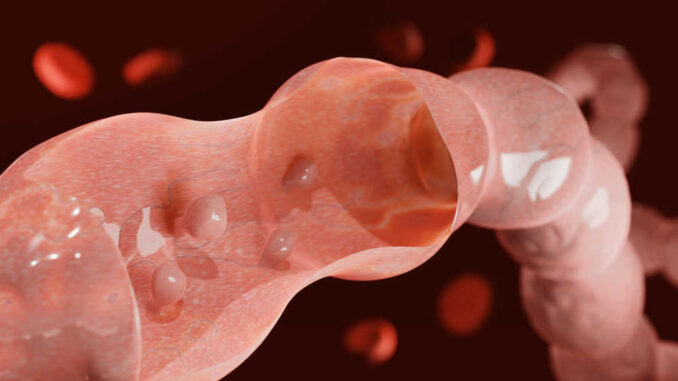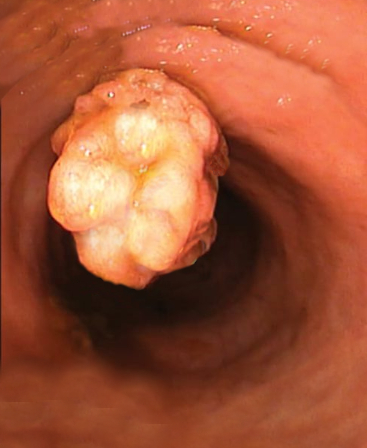
This article was updated on September 16th, 2023
Here’s a topic you may never have wondered about- rectal polyps in your canine companion. It’s one of those issues that we don’t realize is an issue until it becomes a problem. For those pups suffering from rectal polyps, we’re here for you. Let’s talk about the signs of rectal polyps and the most likely treatments.
What are Rectal Polyps? How Serious are They?
A polyp is a growth that stems from a mucous membrane. They can be found in the sinuses, nose, uterus, and even digestive tract. When talking about rectal polyps, we mean those growths that occur in the rectal area of the colon, near the anus. Most rectal polyps are just flap-like lumps made up of the lining of the intestines that can occur as either one singular lump, or multiple with in an area. Some rectal polyps may have a long stem that causes the lump to dangle into the colon.

Here’s the good news about rectal polyps-they are rarely cancerous. Most rectal polyps are benign and only cause issues if they start to interfere with how your dog defecates or if they lead to bleeding from the anus. Occasionally, rectal polyps can be cancerous, so it’s always a good idea to have any rectal polyps checked out by a vet.
How Do Dogs Get Rectal Polyps?
It’s unclear what causes rectal polyps to develop. There is no known inciting issues or predispositions to developing these that vets are aware of. However, we do know that rectal polyps show up more frequently in middle-aged to senior dogs, so age must have something to do with it.
How Do You Know if Your Dog Has Rectal Polyps?
Since rectal polyps are located in the rectum, you won’t necessarily see them. Sure, if they are large enough or if they have a long stalk connecting them to the rectal lining, they may appear as bright red lumps coming out of your dog’s anus.

You may also notice bleeding from the anus or bright red blood on their poop since the surface of the polyp can easily erode when a bowel movement passes through.
Otherwise, dogs with rectal polyps may behave similar to a dog with an anal gland infection. So, they may strain when they try to poop because the polyps are taking up space within the rectum that requires a little extra effort to move the feces past. This may cause some whining or crying as well. You may also notice ribbon-like shapes to your dog’s poop, or again bloody or mucousy covered piles. Scooting their hind-end on the ground or incessant licking may happen as well.
Do Rectal Polyps in Dogs Need Treatment?
Since rectal polyps are most often benign growths, removal isn’t necessary to prevent spreading. However, even benign bumps like these can grow and cause discomfort and bleeding that you don’t want your dog to deal with.
If you notice a bright red lump sticking out of your dog’s anus, don’t hesitate to see a vet. You just want to make sure you’re not dealing with something more serious, such as a cancerous type of lump.
If you notice bright red blood on your dog’s poop, but note that they’re not actively bleeding from their anus or having any other signs, you may choose to wait and see. Having blood on poop for more than a couple bowel movements though should warrant a vet visit.
Straining or crying when defecating should also make you seek veterinary care. You don’t want your dog in pain whether you’re dealing with a cancerous or noncancerous issue.
What is the Treatment for Rectal Polyps in Dogs?
Getting rid of those pesky rectal polyps is a vet-only treatment. There is nothing to be done at-home other than giving your dog some tender loving care and a little understanding.
Diagnosis
Most rectal polyps that can’t be seen through the anus can be felt by your veterinarian through digital palpation. Using a glove and a little lube, your vet will insert their finger into your dog’s rectum similar to how they would do to express anal glands. Of course, they will do a complete physical exam and history as well.
From there, your vet may want to run some blood tests, a fecal test, and even x-rays to check everything out. If available, a colonoscopy may be warranted as well to check for other polyps or to aid in removal.
Cost of diagnosing a rectal polyp can be as low as $50 for an exam or as high as $200-$300 if bloodwork, fecals and x-rays are done.
Treatment
The treatment for rectal polyps in dogs is nearly always surgery. This will remove the problem so that there is no more bleeding or discomfort. No other medications or procedures are really effective at treating rectal polyps.
Surgery to Remove Rectal Polyps in Dogs
Surgery requires general anesthesia, so your dog will have pre-op blood work and an exam to ensure they are healthy enough for the anesthesia. They will also need to fast the night before and morning of surgery.

The procedure is often done by accessing the rectal polyp through the anus. Depending on the size and location, the polyp may be removed by pinching the stalk with a hemostat and stitches to close, or electrocautery may be used. Rectal polyps that are deeper within the rectum may be better removed using colonoscopy to visualize the lump.
Recovery From the Surgery
Dogs are often put on antibiotics, anti-inflammatories, and stool softeners. They will also go home with an e-collar to prevent them from licking the incision. You’ll want to keep your pup on the quiet side for the first couple of weeks to prevent any excessive bleeding or tearing of the stitches. Applying ice to the anus for 10 minutes a couple times a day can help decrease swelling and pain as well.
Most vets will want a recheck in 10-14 days post-op to check healing. They may also request to see your dog back 3-6 months later to check for recurrence.
Success Rate of Rectal Polyp Surgery in Dogs
For dogs that have one rectal polyp, surgery is very successful. Chances of the polyp returning are very small. Dogs that have multiple or large polyps may experience recurrence. That is why it’s important to schedule those follow-up appointments with your vet to catch any repeats while they are small.
Large polyps also carry a greater chance of being malignant, or cancerous. Because of this, any large polyp, or any polyp for that matter, should be checked for malignancy. Dogs that have larger polyps removed should have frequent rechecks.
Cost
The cost of removing rectal polyps in dogs is going to vary based on size, number, and how they are removed. Removal using colonoscopy may be more expensive than removal without. Look to pay $500-$1,500 to have a rectal polyp removed.
Potential Risks and Complications of Rectal Polyp Surgery
Most dogs recover from a rectal polyp removal surgery without missing a step. These are more often those dogs that have small, singular polyps. Dogs that have multiple or large polyps may have a tougher time and experience some pain, swelling, and bleeding that can last anywhere from a couple of days to a couple of weeks following surgery.
Dogs with multiple or large rectal polyps also have a greater chance that these lumps will come back. Your vet will recommend frequent check-ups if your dog is at risk. Another rare complication to rectal polyp removal is a narrowing of the anus due to scar tissue formation or inflammation. Stool softeners and anti-inflammatories will be given to help this in the short-term. Long-term management may require a diet change and stool softening supplements.
Disclaimer: This website's content is not a substitute for veterinary care. Always consult with your veterinarian for healthcare decisions. Read More.


Thank you for writing this. I recently visited the vet for a normal anal gland visit to be told he had a lump, then a vet confirmed it was a polyp and not to consider an operation now. I have been so worried and my googling has not helped, and made me think it is malignant. He has been scooting and nibbling in an area close to his anus. But reading this article has helped put my mind at ease. I will keep an eye on him and arrange a visit soon to make sure it isn’t changing. Thank you